

 |
Search the Site with

|
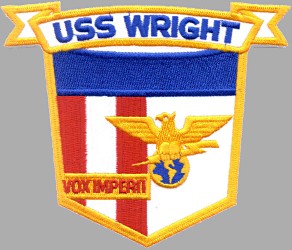 | 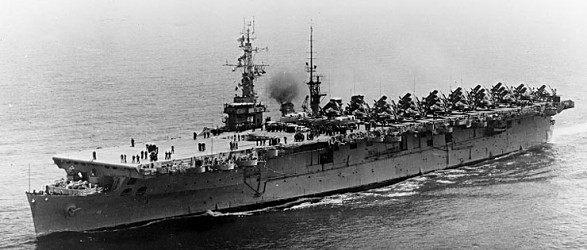 |
USS WRIGHT was the second of the two SAIPAN - class light aircraft carriers. Unlike the light aircraft carriers of the INDEPENDENCE - class, the WRIGHT was built from the keel up as an aircraft carrier.
USS WRIGHT was the second ship to bear the name. The first WRIGHT (AZ 1) was named for Orville Wright; the second, CVL 49, honored both Wright brothers: Orville and Wilbur. Decommissioned on March 15, 1956, WRIGHT was chosen for conversion as a command ship in the early 1960s. Reclassified as CC 2, she was recommissioned as USS WRIGHT (CC 2) on May 11, 1963. Finally decommissioned on May 27, 1970, WRIGHT was subsequently laid up at Philadelphia, Penn., and was sold for scrap in 1980.
| General Characteristics: | Awarded: 1943 |
| Keel laid: August 21, 1944 | |
| Launched: September 1, 1945 | |
| Commissioned: February 2, 1947 | |
| Decommissioned: March 15, 1956 | |
| Builder: New York Shipbuilding, Camden, N.J. | |
| Propulsion system: geared turbines, 120,000 shp | |
| Propellers: four | |
| Length: 684 feet (208 meters) | |
| Beam: 115 feet (35 meters) | |
| Draft: 28 feet (8.5 meters) | |
| Displacement: 14,500 tons | |
| Speed: 33 knots | |
| Aircraft: 50+ | |
| Catapults: two | |
| Aircraft Elevators: two | |
| Armament: 40 40mm Bofors guns, 25 20mm guns | |
| Crew: 1721 |
Crew List:
This section contains the names of sailors who served aboard USS WRIGHT. It is no official listing but contains the names of sailors who submitted their information.
USS WRIGHT Cruise Books:
USS WRIGHT History:
WRIGHT was laid down on 21 August 1944 at Camden, N.J., by the New York Shipbuilding Corp.; launched on 1 September 1945; sponsored by Mrs. Harold S. Miller, a niece of the Wright brothers; and commissioned at the Philadelphia Naval Shipyard on 9 February 1947, Capt. Frank T. Ward in command.
WRIGHT departed Philadelphia on 18 March 1947 and stopped briefly at Norfolk, Va., en route to the Naval Air Training Base at Pensacola, Fla. After her arrival there on 31 March, WRIGHT soon commenced a rigorous schedule of air defense drills and gunnery practice while acting as a qualification carrier for hundreds of student pilots at the Naval Air Training Base, conducting 40 operational cruises, each of between one and four days' duration off the Florida coast. In addition, the carrier embarked a total of 1,081 naval reservists and trained them in a series of three two-week duty tours.
On 3 September 1947, WRIGHT embarked 48 midshipmen for temporary training duty and later welcomed 62 Army officers when she stood out to sea on 15 October in company with FORREST ROYAL (DD 872) to let her guests observe flight operations in the Pensacola area. The exercises included the catapulting of a Grumman P6F-type aircraft for rocket-firing operations.
That exercise was her last prior to her departure from Pensacola on 24 October to return north. She arrived at the Philadelphia Naval Shipyard soon thereafter and, from 1 November to 17 December, underwent post-shakedown repairs and alterations before she returned to Pensacola two days before Christmas where she resumed her regular schedule of pilot qualification training under the operational control of the Chief of Naval Air Training, Commander Air Atlantic. WRIGHT spent the year 1948 engaged in those pilot carrier qualification operations, before she put into the Norfolk Naval Shipyard on 26 January 1949 to commence a four-month overhaul.
Following refresher training in Cuban waters, WRIGHT returned to Norfolk on 1 August 1949 and four days later shifted to Newport, R.I., for two weeks of antisubmarine warfare (ASW) training in the Narragansett Bay area with submarines and destroyers. She also visited New York City before taking up a steady schedule of carrier qualifications, air defense tactics and exercises out of Quonset Point, R.I.; Key West and Pensacola, Fla. But for 10 days of maneuvers with the 2d Task Fleet from 21 to 31 October 1949, she continued that duty until 7 January 1951, when she embarked the last increment of personnel from Fighter Squadron (VF) 14 for temporary duty.
WRIGHT then sailed from Norfolk on 11 January with a fast carrier task group and reached Gibraltar on the 21st for her first tour of duty with the 6th Fleet in the Mediterranean. WRIGHT's first Mediterranean deployment took her from Gibraltar to Oran, Algeria. She proceeded thence to Augusta Bay, Sicily; Souda Bay, Crete; Beirut, Lebanon; and Golfe Juan, France, her replenishment and liberty ports during the never-ending cycle of fleet training and readiness exercises with the 6th Fleet.
Departing Golfe Juan on 19 March, WRIGHT made port at Newport on the 31st. The carrier later entered the Norfolk Naval Shipyard and underwent an overhaul there before she took part in Atlantic Fleet maneuvers out of Guantanamo Bay, Cuba; engaged in ASW tactics and carrier operations in Narragansett Bay; received further repairs at the Boston Naval Shipyard; and participated in a convoy exercise that ran from 25 February to 21 March 1952; and ranged from Newport to waters of the Panama Canal Zone and Trinidad in the British West Indies.
As flagship for Carrier Division (CarDiv) 14, WRIGHT sailed on 9 June 1952 in company with four destroyers, forming Task Group (TG) 81.4 for ASW operations along the Atlantic seaboard until the 27th, when the ships arrived at New York City. Returning to Quonset Point on 1 July, WRIGHT trained units of the organized naval reserves concurrently with hunter-killer tactics and pilot training in operations out of Narragansett Bay until 26 August. On that day, she set course from Quonset Point and later rendezvoused with Vice Admiral Felix B. Stump's 2d Task Fleet en route to northern Europe for combined defense exercises and maneuvers with naval units of other North Atlantic Treaty Organization (NATO) navies.
En route, WRIGHT, escorted by FORREST ROYAL, was detached to ferry men and gear of Marine Night Fighter Squadron (VMF(N)) 114 to Port Lyautey, French Morocco, an operation she completed on 4 September. Two days later, WRIGHT and her escort rejoined the task force; and they reached the Firth of Clyde, Scotland, on the 10th.
Three days later, WRIGHT put to sea with two British destroyers acting as her plane guard for NATO Operation "Mainbrace." She conducted air defense maneuvers and tactics evolutions with the British carriers HMS ILLUSTRIOUS (R 87) and HMS EAGLE (R 05) en route to Rotterdam, Holland, where the force arrived on the 25th. On 29 September, WRIGHT departed Rotterdam, bound for the United States, and arrived at Newport on 9 October.
That day, she embarked Rear Admiral W. L. Erdman, Commander, Carrier Division 4, and spent the next few months engaged in carrier qualification duties in waters ranging from Newport to the Virgina capes, before she began her second deployment to the Mediterranean. She reached Golfe Juan on 21 February 1953 and operated with the 6th Fleet until 31 March, when she sailed for home, via the Azores.
WRIGHT returned to Newport and, after a rigorous schedule of training in Narragansett Bay, sailed on 5 May for the Gulf of Mexico. During that training cruise, she visited Houston, Tex., where she hosted some 14,000 visitors on 16 and 17 May. Returning to Quonset Point on 28 May, WRIGHT operated locally for another month before shifting south for a stint of operations out of Mayport, Fla.
WRIGHT was overhauled at the Philadelphia Naval Shipyard from 31 July to 21 November and then conducted refresher training in Cuban waters from 4 January to 16 February 1954. Next, after departing Davisville, R.I., on 5 April, WRIGHT sailed for the Far East, via the Panama Canal; San Diego, Calif.; and Pearl Harbor, and reached Yokosuka, Japan, on 28 May. The carrier, with Marine Attack Squadron 211 embarked, operated with the 7th Fleet off both coasts of Korea and also off Okinawa before she visited Hong Kong from 24 to 30 September. Departing Yokosuka on 15 October, WRIGHT arrived at San Diego on the last day of October and entered the Long Beach Naval Shipyard where she remained until 23 February 1955.
At that point, WRIGHT was attached to CarDiv 17, Pacific Fleet, and operated locally out of San Diego until 3 May, when she put to sea as part of TG 7.3, formed around the flagship MOUNT McKINLEY (AGC 27), for the atomic test, Operation "Wigwam," carried out in Pacific waters. Returning to the west coast on 20 May, WRIGHT subsequently cruised to Pearl Harbor briefly before she entered the Mare Island Naval Shipyard on 14 July to commence preparation for inactivation. After shifting to the Puget Sound Naval Shipyard, Bremerton, Wash., on 17 October, for the final phase of preservation for inactivation, WRIGHT was decommissioned at Puget Sound on 15 March 1956 and assigned to the Bremerton group of the Pacific Reserve Fleet.
During her time in reserve, WRIGHT was reclassified on 15 May 1959 an auxiliary aircraft transport, AVT 7. However, she never served in that role; but remained inactive until 15 March 1962, when she was taken to the Puget Sound Naval Shipyard for conversion to a command ship and reclassified as CC 2. The conversion (which lasted a year) included extensive alterations to enable the ship to function as a fully equipped mobile command post afloat for top echelon commands and staff for strategic direction of area or world-wide military operations. Facilities were built into the ship for world-wide communications and rapid, automatic exchange, processing, storage, and display of command data. A portion of the former hangar deck space was utilized for special command spaces and the extensive electronics equipment required, while a major portion of the flight deck was utilized for specially designed communications antenna arrays. In addition, facilities were provided to enable the ship to operate three helicopters.
Recommissioned at Puget Sound on 11 May 1963, Capt. John L. Arrington, II, in command, WRIGHT (CC 2) remained in service until 27 May 1970. Subsequently laid up at Philadelphia, she was sold for scrapping 1 August 1980.
USS WRIGHT Image Gallery:
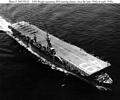 | 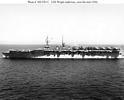 | 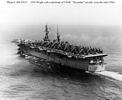 |
 Back to Light Aircraft Carriers list.
Back to Light Aircraft Carriers list.  Back to Ships list.
Back to Ships list.  Back to selection page.
Back to selection page.  Back to 1st page.
Back to 1st page.